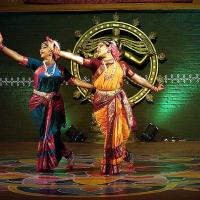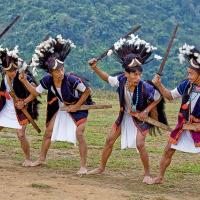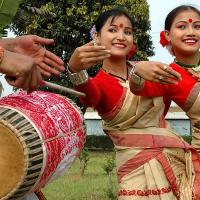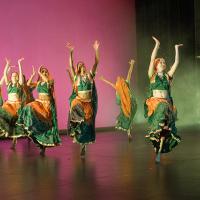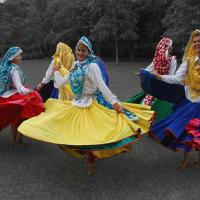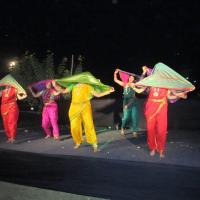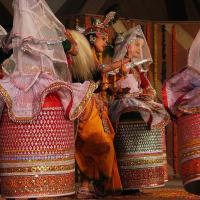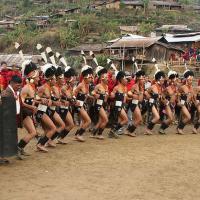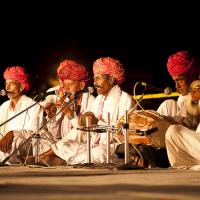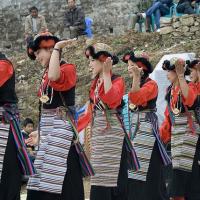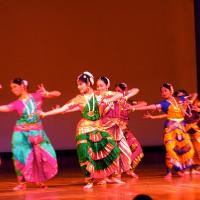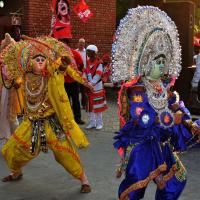Andaman and Nicobar is home to many indigenous tribes and tribes that settled here from other parts of the world. Thus Andaman and Nicobar has an amalgamation of different cultures. And dances of these tribes represent the distinctness in cultures. Nicobari dance is one the most important and oldest traditional dances of Andaman & Nicobar. It is practiced by the Nicobari tribe, who live in the Car Nicobar Island. One can witness the Nicobari dance during the Ossuary Feast, which is more commonly known as the Pig Festival.
Music & Dance
In Andhra there are nearly thirty-three kinds of foresters, hill men and tribals. All have, their own dances. These dances can be broadly classified into three heads (i) Religious dances (ii) Social dances (iii) Dance as a past time.
Kuchipudi, one of the classical dance forms of the South had its origin in Andhra Pradesh.
The dances, performed by the tribes of Arunachal Pradesh, have been broadly divided into four groups. The first group is the ritual dances which may again be divided into five sub-groups. The first sub-groups includes those dances which form part of the various rituals performed to secure prosperity, good health and happiness of the dancer, his family, village or the whole community. The second sub-group comprises of those dances performed in ceremonies related to agriculture and domestication of animals to secure a good harvest and increase of domestic animals respectively.
Dance culture of Assam also represent another facet of Assam rich culture. There are two well known dance form in Assam, namely the Bihu Dance and the Sattriya Dance. Bihu dance is mostly performed during the Bihu festival and Sattriya Dance is a classical form of dance often termed together with the most popular classical dance of India like Kathak, Bharatnatyam etc.
Over thousands of years various traditional dance forms have evolved in Bihar. The folk dance tradition in Bihar can be divided into three groups. First, the dance performed during poetry performance. The second stream is those of the tribal people who are closer to mother earth and their dances are heavily influenced by indigenous development. The third stream relates to the other regions of south Bihar. Most of the folk dances are religious in nature, in which, gods and goddesses are invoked through dance, performed to the rhythm of folk songs and music.
Folk music
Chandigarh has a rich tradition of folk dances, borrowed from the parent states of Punjab and Haryana. The people of the city are very lively and celebrate all the occasions to the fullest, with the folk dances accompanying each of them almost always. Bhangra, Giddha, Jhumar, Luddi, Julli, Dhamal, Sammi, Jaago, Teeyan, Dankara, Kikili and Gatka are some of the popular folk dances of the city.
Dance and Music are very much part of the daily life of Damanite. Here is a true fusion of cultures - tribal, urban, European and Indian. This ornate amalgam is reflected in the traditional dances of Daman. Various Portuguese dances are well preserved and still widely presented. Tribal dances with caustic social comments are much in vogue. Incredible India Tours with Indian Travel agent.
India is a land of music and dance, and Delhi is no exception. The music engenders both a spirit of identity and provides entertainment as relief from the daily grind of wrenching a living from a modern way of fast-paced lifestyle. There is a unavoidable medley in Delhi's music which comes from a tradition that is old and tranquil, and from a culture that has imbibed the best from all over the country. People from all over the nation come here to perform, and Delhi echoes the pulse with an immense concentration all through the night.
Besides being a heaven of natural beauty and serenity, Goa is also a land of artistic people who are credited for lending the region with a rich cultural heritage, amalgamating the east and west perfectly. Besides the different forms of traditional dance and music, each region of the state also has its own unique form. The urban areas have also adopted western and other music forms from around the world. Indian Travel Agent offers Visit India and explore India.
Dance forms of Goa
Gujarat has been successful in preserving its rich tradition of song, dance and drama. The state is known for its popular folk dances like Ras, Garba, Garbi, Rasaka, Tippani, Padhar-Nritya,and Dangi-Nritya. Tour Incredible India with Indian Travel agent.
Folk drama in Gujarat is known as Bhavai. Most of the art traditions trace back their origin to the ancient period of Lord Krishna.
The contribution of Gujarat to the Indian traditional music is no less encouraging. Tour Incredible India with Indian Travel agent.There are several ragas named after various regions of the state – Gujaqri Todi, Bilaval (from Veraval), Sorathi, (from Sorath), Khambavati (from Khambhat, Cambay), Ahiri and Lati. These ragas are valuable gifts to the Indian classical music.
The tradition of music and dance goes back to the times when India was the land of kings and queens, princes and princesses. The people have simple tastes and preferences and have their own distinctive lifestyle.
Music in Haryana
Every dance is accompanied with music or singing which, in India, can sound like music when sung like it is supposed to be sung. The tradition of music in Haryana goes back to the Vedic times, and it is the only state in India to have towns and villages named after different ragas.
It is said that dance is one of the best mediums through which you can express yourself. So, what better way to know about the culture of the state than through exploring its various dance forms. The people of Maharashtra celebrate a large number of fairs and festivals and dancing, as a part of the celebration, is a feature that is common in almost all of them. Apart from that, there are a number of special occasions, such as weddings, where dance makes a part of the festivity. In this article, we have provided information on the most popular folk dances of the state.
Dance is the most important part of Maharashtrian culture. Various folk dances are performed during festivals and special occasions. The important dances of the state are described below.
Its own art-forms and cultural expressions and ramifications distinctly showcase Manipur to the World. Its famous classical dance remains unique in all Manipuri dance forms whether it,s folk, classical or modern and has a different style and gesture of movement.
Love of art and beauty is inherent in the people and it is difficult to find a Manipuri girl who cannot sing or dance. Manipuris are artistic and creative by nature. This has found expression in their handloom and handicraft products, which are world-famous for their designs, ingenuity, colorfulness and usefulness.
Meghalaya is the home of music and dances. The dances are associated with their festivals or seasons and hence are to be enjoyed through out the year. The dances are social, religious, agricultural, funeral and recreational. The land echoes the sound of perfect tempo, beautiful songs and traditional instruments. The dances of Meghalaya are generally held under the open sky.
The state has also a variety of folk dances depicting the way of life of the people. The most widely seen and popular among them are the Cheraw and Khuallum Dance. The people dance and enjoy the festivals in much enthusiasm, which is the indication of their rich tradition and vibrant people. The male performer usually wears shirt that are sleeveless and wrap-around-traditional clothes. The female wears a longer wrap-around and shirt with sleeves. But depending upon the dance they may or may not wear a headgear.
The term "Naga" is a general one, which covers many tribes of that region. Thus, Nagaland is the home of various hill-tribes and the dances performed by these different tribal communities are altogether, most popularly known as Naga dances. All these dances have been deeply rooted in their environment, occupations, religious beliefs and practices and the social patterns that prevail here.
'Odissi', the traditional dance of Orissa, has been accepted as an important classical form of Indian dance for its exquisite beauty and charm. Among the folk dances of Orissa, 'chhau' has earned world-wide reputation.
The people of Rajasthan live life to the hilt. After hard work in the harsh desert sun and the rocky terrain whenever they take time off they let themselves go in gay abandon. There is dancing, singing, drama, devotional music and puppet shows and other community festivities which transform the hardworking Rajasthani into a fun-loving and carefree individual. Each region has its own folk entertainment, the dance styles differ as do the songs. Interestingly enough, even the musical instruments are different.
The cultural heritage of Sikkim is expressed in its traditional folk dances. Sikkim is domiciled by many ethnic castes and tribes; each of them has its own interesting folk dances. The major inhabitants of Sikkim are divided into three communities, the Lepchas, the Bhutias and the Nepalese respectively. The folk dances and music have become an inseparable part of Sikkim Culture. A majority of the dances are associated with the startling beauty of the natural environs. Some of them depict the harvest season and other dances are performed for opulence. The traditional dances of Sikkim go together with the tunes of many musical instruments.
Dance in South-India, is anchored to age-old tradition. This vast sub-continent has perpetuated to varied forms of dancing, each shaped by the influences of a particular period and environment. These pristine forms have been preserved through the centuries, to become a part of our present culture, a living heritage which is both our pride and delight. Nurtured in temples, princely courts or villages, dance has moved into the auditorium of today, bringing pleasure to many more people, in far-flung regions.
Uttar Pradesh has a very vibrant culture. Various rulers who have ruled Utter Pradesh in the course of history have consolidated the culture of this state. The same effect can be clearly seen on the songs and dances of this state after all these too are an integral part of any culture.
The dances in Uttar Pradesh can be broadly classified in to two categories namely Classical and Folk. The first group comprises Kathak where as the later has Charkula, Karma and Dadra in its list. Kathak is one of the most famous classical dances of India. The dance has its origin in the courts of Emperors and Nawabs but it has traversed a long path to come to the masses. UP has produced some of the greatest exponents of this art form.
West Bengal is renowned for its rich art and culture as well as the intellectual aura of its people. The richness of Bengali culture also reflects in the music of the state. Music, more than being an art, is a passion for Bengalis. More than a millennium old, Bengali music has become diverse with so many varieties within. The variety is such that once you get familiar with it, you will not need to look beyond it. From classical to rock, folk to devotional, you will get almost every possible music form in Bangla Sangeet. Then, there is the display of a wide range of emotions - be it love, sadness, anxiety, motivation, devotion or spirituality. Let us know more about the music of West Bengal.

